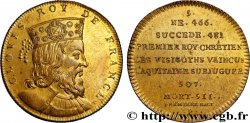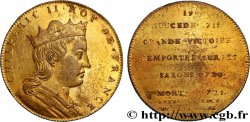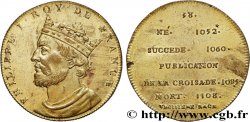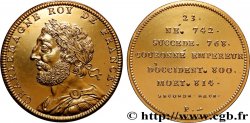E-auction 636-637546 - fme_1018769 - SÉRIE MÉTALLIQUE DES ROIS DE FRANCE Médaille, Charlemagne - 23 - refrappe ultra-moderne
Sie müssen angeschlossen sein und von cgb.fr genehmigt werden, um in einer E-Auktion teilzunehmen.Melden Sie sich an, um zu wetten..Die Kontobestätigungen sind innerhalb von 48 Stunden nach Ihrer Anmeldung gemacht.Warten Sie nicht bis die letzten zwei Tage vor dem Abschluss eines Verkaufs, um Ihre Registrierung abzuschließen. Klickend "BIETEN" verpflichten Sie sich vertraglich, diesen Artikel zu kaufen und Sie nehmen ohne Reserve die allgemeinen Verkaufsbedingungen für den e-auctions zu cgb.fr an.
Der Verkauf wird an der Zeit auf der Übersichtsseite angezeigt geschlossen werden. Angebote, die nach der Schließung Zeit empfangen sind, werden nicht gültig.
Bitte beachten Sie, dass die Fristen für die Einreichung Ihres Angebots auf unsere Server können variieren und es kann zur Ablehnung Ihres Angebots entstehen, wenn es in den letzten Sekunden des Verkaufs gesendet wird. Die Angebote sollen mit ganzer Zahl ausgeführt sein, Sie können Kommas oder des Punktes in Ihrem Angebot nicht erfassen. Bei Fragen klicken Sie hier, um einen Blick auf die FAQ E-Auktionen.
KEINE ANSCHAFFUNGSKOSTEN FÜR DIE KÄUFER.
KEINE ANSCHAFFUNGSKOSTEN FÜR DIE KÄUFER.
| Schätzung : | 20 € |
| Preis : | 3 € |
| Höchstgebot : | 6 € |
| Verkaufsende : | 23 Juni 2025 20:20:40 |
| Bieter : | 2 Bieter |
Type : Médaille, Charlemagne - 23 - refrappe ultra-moderne
Datum: n.d.
Metall : vergoldete Bronze
Durchmesser : 34 mm
Stempelstellung : 12 h.
Gewicht : 20,75 g.
Rand cannelée
Punze : corne d’abondance
Kommentare zum Erhaltungszustand:
Patine hétérogène avec des traces de manipulation et rayures
Vorderseite
Titulatur der Vorderseite CHARLEMAGNE ROY DE FRANCE.
Beschreibung Vorderseite Buste imaginaire lauré, cuirassé et drapé à gauche.
Rückseite
Titulatur der Rückseite 23. / NÉ. 742. / SUCCEDE. 768. / COURONNÉ EMPEREUR / D’OCCIDENT. 800. / MORT. 814. / SECONDE RACE. / P..
Beschreibung Rückseite Légende en 8 lignes.
Kommentare
Médaille conservée sous capsule et dorée à l’or fin. Refrappe ultra-moderne des séries de jetons.
Charles Ier, dit le Grand ou Charlemagne (en latin Carolus Magnus, en allemand Karl der Große), est né le 2 avril, probablement en 742 ou 748, sans certitude quant au lieu de naissance. Il est mort à Aix-la-Chapelle le 28 janvier 814. Il est roi des Francs (768-814), devient par conquête roi des Lombards (774-814) et est couronné empereur par le pape Léon III le 25 décembre 800, relevant une dignité prestigieuse disparue depuis l'an 476 en Occident.
Monarque guerrier, il agrandit notablement son royaume par une série de campagnes successives, en particulier par la lente mais néanmoins violente soumission des Saxons païens (772-804). Souverain réformateur, soucieux d'orthodoxie religieuse et de culture, il protège les arts et les lettres et est à l'origine de la « renaissance carolingienne ».
Son œuvre politique immédiate ne lui survit pas longtemps. Respectueux de la tradition germanique en matière successorale, Charlemagne avait prévu le partage de l'Empire entre ses trois fils dès 806. L'empire ne sera finalement partagé entre ses trois petits-fils qu'au traité de Verdun en 843. Le morcellement féodal des siècles suivants, puis la division de l'Europe en États-Nations rivaux condamnent à l'impuissance ceux qui tentent explicitement de restaurer l'empire universel de Charlemagne, en particulier les souverains du Saint-Empire romain germanique, d'Otton Ier en 962 à Charles Quint au XVIe siècle, ou encore Napoléon Ier, hanté par l'exemple du plus éminent des Carolingiens.
Pour la suite de sa biographie, voir http://fr.wikipedia.org/wiki/Charlemagne.
Medal preserved in a capsule and gilded with fine gold. Ultra-modern re-minting of token series.
Charles I, known as the Great or Charlemagne (in Latin Carolus Magnus, in German Karl der Große), was born on April 2, probably in 742 or 748, without certainty as to the place of birth. He died in Aix-la-Chapelle on January 28, 814. He was king of the Franks (768-814), became king of the Lombards by conquest (774-814) and was crowned emperor by Pope Leo III on December 25, 800, reviving a prestigious dignity that had disappeared in the West since the year 476..
A warrior monarch, he significantly expanded his kingdom through a series of successive campaigns, in particular through the slow but nevertheless violent submission of the pagan Saxons (772-804). A reforming sovereign, concerned with religious orthodoxy and culture, he protected the arts and literature and was at the origin of the \\\"Carolingian renaissance\\\".
His immediate political work did not long outlive him.. Respectful of the Germanic tradition in matters of succession, Charlemagne had planned the division of the Empire between his three sons from 806. The empire was finally divided between his three grandsons only at the Treaty of Verdun in 843.. The feudal fragmentation of the following centuries, then the division of Europe into rival nation-states, condemned to impotence those who explicitly attempted to restore the universal empire of Charlemagne, in particular the sovereigns of the Holy Roman Empire, from Otto I in 962 to Charles V in the 16th century, or even Napoleon I, haunted by the example of the most eminent of the Carolingians..
For the rest of his biography, see http://fr. Wikipedia. org/wiki/Charlemagne
Charles Ier, dit le Grand ou Charlemagne (en latin Carolus Magnus, en allemand Karl der Große), est né le 2 avril, probablement en 742 ou 748, sans certitude quant au lieu de naissance. Il est mort à Aix-la-Chapelle le 28 janvier 814. Il est roi des Francs (768-814), devient par conquête roi des Lombards (774-814) et est couronné empereur par le pape Léon III le 25 décembre 800, relevant une dignité prestigieuse disparue depuis l'an 476 en Occident.
Monarque guerrier, il agrandit notablement son royaume par une série de campagnes successives, en particulier par la lente mais néanmoins violente soumission des Saxons païens (772-804). Souverain réformateur, soucieux d'orthodoxie religieuse et de culture, il protège les arts et les lettres et est à l'origine de la « renaissance carolingienne ».
Son œuvre politique immédiate ne lui survit pas longtemps. Respectueux de la tradition germanique en matière successorale, Charlemagne avait prévu le partage de l'Empire entre ses trois fils dès 806. L'empire ne sera finalement partagé entre ses trois petits-fils qu'au traité de Verdun en 843. Le morcellement féodal des siècles suivants, puis la division de l'Europe en États-Nations rivaux condamnent à l'impuissance ceux qui tentent explicitement de restaurer l'empire universel de Charlemagne, en particulier les souverains du Saint-Empire romain germanique, d'Otton Ier en 962 à Charles Quint au XVIe siècle, ou encore Napoléon Ier, hanté par l'exemple du plus éminent des Carolingiens.
Pour la suite de sa biographie, voir http://fr.wikipedia.org/wiki/Charlemagne.
Medal preserved in a capsule and gilded with fine gold. Ultra-modern re-minting of token series.
Charles I, known as the Great or Charlemagne (in Latin Carolus Magnus, in German Karl der Große), was born on April 2, probably in 742 or 748, without certainty as to the place of birth. He died in Aix-la-Chapelle on January 28, 814. He was king of the Franks (768-814), became king of the Lombards by conquest (774-814) and was crowned emperor by Pope Leo III on December 25, 800, reviving a prestigious dignity that had disappeared in the West since the year 476..
A warrior monarch, he significantly expanded his kingdom through a series of successive campaigns, in particular through the slow but nevertheless violent submission of the pagan Saxons (772-804). A reforming sovereign, concerned with religious orthodoxy and culture, he protected the arts and literature and was at the origin of the \\\"Carolingian renaissance\\\".
His immediate political work did not long outlive him.. Respectful of the Germanic tradition in matters of succession, Charlemagne had planned the division of the Empire between his three sons from 806. The empire was finally divided between his three grandsons only at the Treaty of Verdun in 843.. The feudal fragmentation of the following centuries, then the division of Europe into rival nation-states, condemned to impotence those who explicitly attempted to restore the universal empire of Charlemagne, in particular the sovereigns of the Holy Roman Empire, from Otto I in 962 to Charles V in the 16th century, or even Napoleon I, haunted by the example of the most eminent of the Carolingians..
For the rest of his biography, see http://fr. Wikipedia. org/wiki/Charlemagne








 Berichten über einen Fehler
Berichten über einen Fehler Die Seite drucken
Die Seite drucken Teilen meiner Auswahl
Teilen meiner Auswahl Stellen Sie eine Frage
Stellen Sie eine Frage Einlieferung/Verkauf
Einlieferung/Verkauf
 Details
Details










